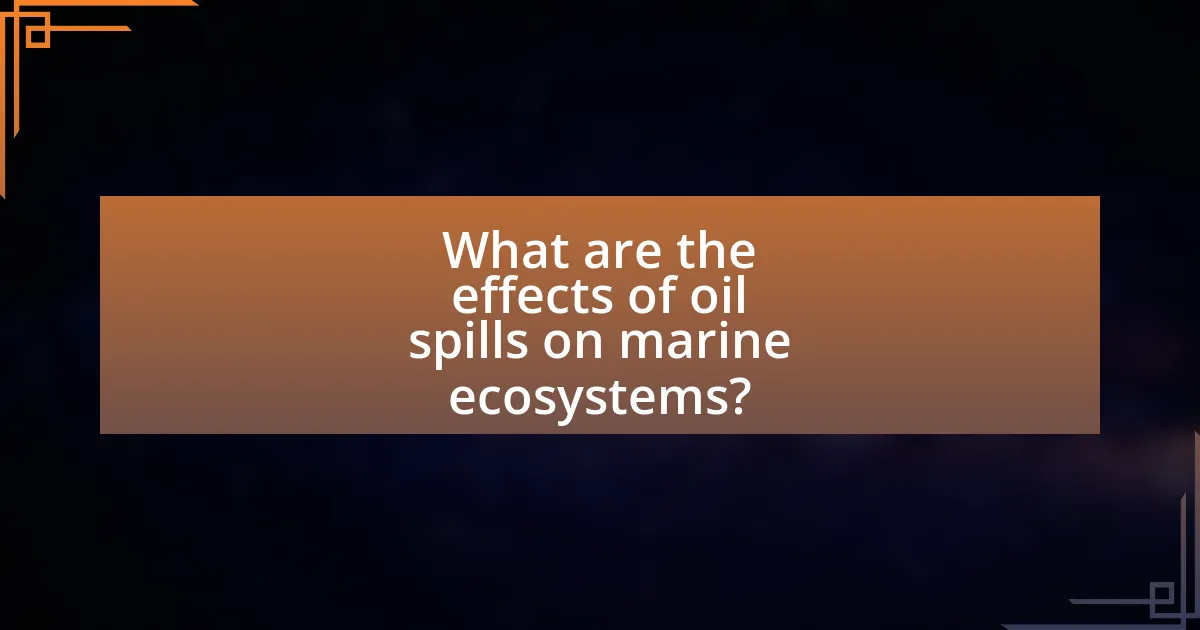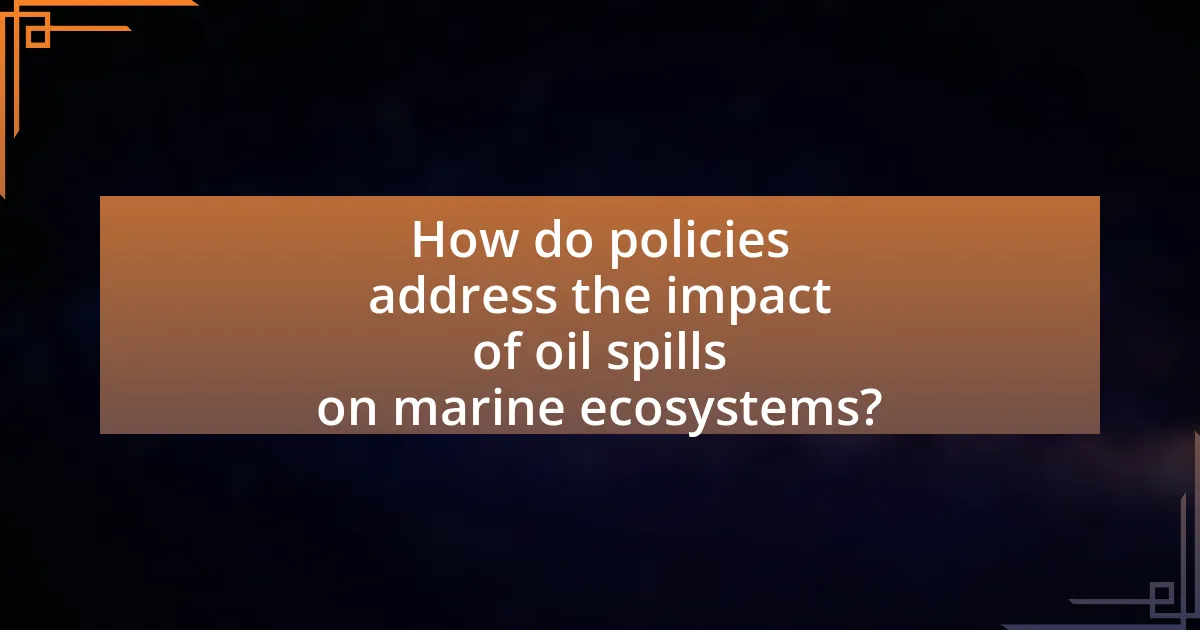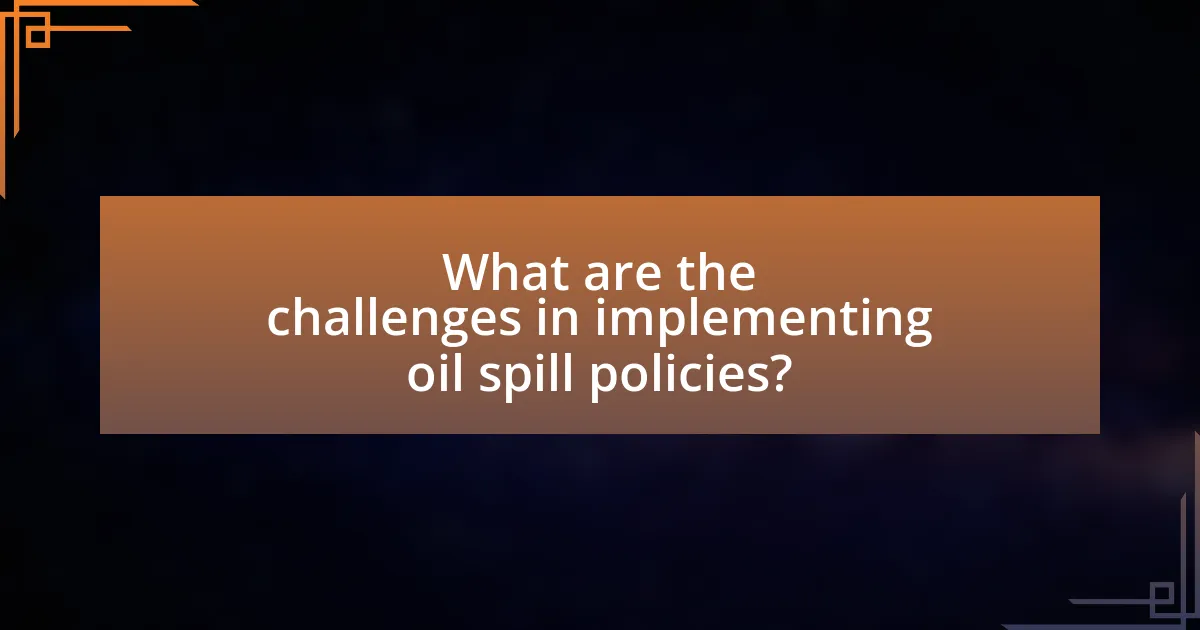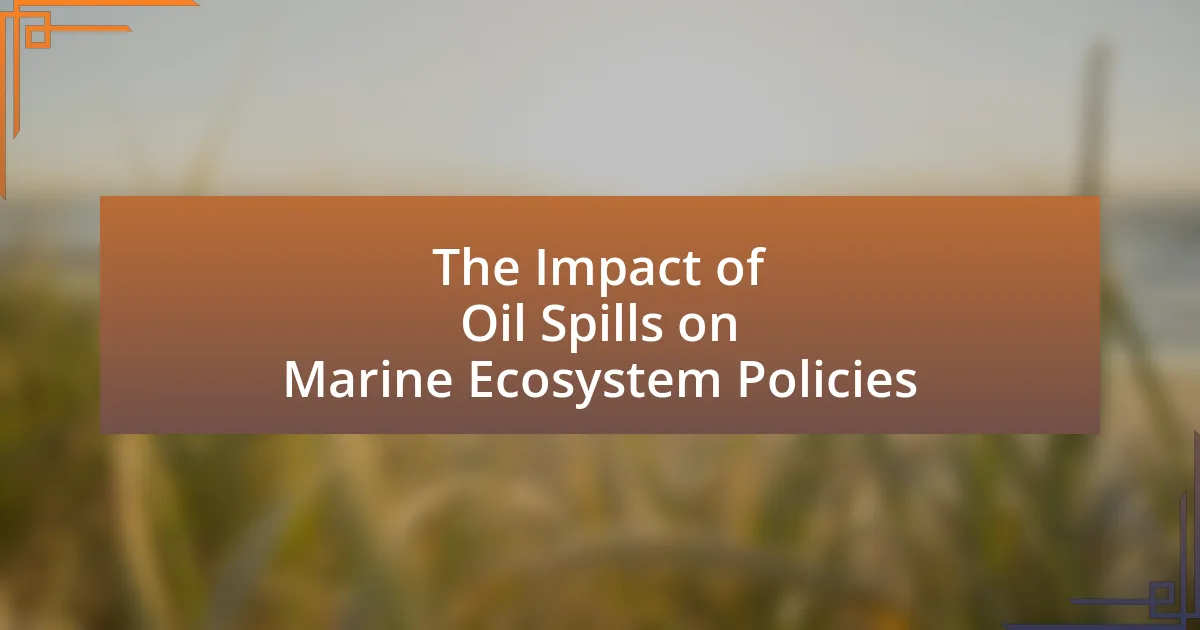The article examines the significant impact of oil spills on marine ecosystems and the policies designed to address these effects. It details the immediate and long-term consequences of oil spills, including habitat destruction, toxicity to marine life, and alterations in species composition. The discussion includes the most affected species, the ecological changes caused by oil contamination, and the effectiveness of current regulations and response strategies. Additionally, it highlights the challenges in policy implementation and suggests improvements for future oil spill management, emphasizing the role of technology and community engagement in protecting marine environments.

What are the effects of oil spills on marine ecosystems?
Oil spills have devastating effects on marine ecosystems, leading to habitat destruction, toxicity to marine life, and long-term ecological changes. The immediate impact includes the coating of marine organisms and habitats with oil, which can cause suffocation, poisoning, and death. For instance, the Exxon Valdez oil spill in 1989 resulted in the death of thousands of seabirds, marine mammals, and fish, severely disrupting the local ecosystem. Additionally, oil spills can lead to bioaccumulation of toxic substances in the food chain, affecting not only individual species but also entire populations and communities. Long-term effects may include altered reproductive success, decreased biodiversity, and changes in species composition, as seen in the aftermath of the Deepwater Horizon spill in 2010, which caused significant declines in fish populations and disrupted the Gulf of Mexico’s ecological balance.
How do oil spills impact marine life?
Oil spills severely impact marine life by causing immediate harm to organisms and disrupting ecosystems. Marine species, including fish, birds, and mammals, suffer from toxic exposure to oil, which can lead to death, reproductive failure, and long-term health issues. For instance, studies have shown that oil exposure can impair the immune systems of fish and cause developmental abnormalities in embryos. Additionally, oil spills can devastate habitats such as coral reefs and mangroves, which are crucial for the survival of many marine species. The 2010 Deepwater Horizon oil spill resulted in the death of thousands of marine animals and long-lasting ecological damage, highlighting the significant and detrimental effects of oil spills on marine ecosystems.
What species are most affected by oil spills?
Marine species most affected by oil spills include seabirds, marine mammals, fish, and invertebrates. Seabirds suffer from feather contamination, which impairs their insulation and buoyancy, leading to hypothermia and drowning. Marine mammals, such as seals and otters, experience similar issues with fur and skin contamination, affecting their ability to regulate body temperature. Fish populations can be impacted through direct exposure to toxic compounds in oil, which can lead to developmental and reproductive issues. Invertebrates, including mollusks and crustaceans, are also vulnerable as oil can disrupt their habitats and life cycles. Studies have shown that oil spills can lead to significant declines in these species, highlighting the critical need for effective marine ecosystem policies to mitigate such impacts.
How does oil contamination alter marine habitats?
Oil contamination significantly alters marine habitats by disrupting the physical and chemical properties of water, leading to detrimental effects on marine life. The introduction of hydrocarbons from oil spills can create toxic environments that impair the growth and reproduction of aquatic organisms, including fish, invertebrates, and plants. For instance, studies have shown that oil exposure can cause physiological stress in marine species, leading to decreased survival rates and biodiversity loss. Additionally, oil can coat the seabed, smothering benthic organisms and disrupting food webs. Research conducted by the National Oceanic and Atmospheric Administration (NOAA) indicates that oil spills can result in long-term ecological impacts, with some species taking years to recover fully.
What are the short-term and long-term consequences of oil spills?
Oil spills have significant short-term and long-term consequences on marine ecosystems. In the short term, oil spills can cause immediate harm to marine life, including fish, birds, and mammals, leading to acute toxicity, habitat destruction, and mortality. For example, the Exxon Valdez oil spill in 1989 resulted in the death of hundreds of thousands of seabirds and marine mammals due to exposure to toxic oil compounds.
In the long term, the consequences include chronic health effects on marine organisms, disruption of reproductive systems, and long-lasting damage to habitats such as coral reefs and mangroves. Studies have shown that oil can persist in the environment for decades, affecting the food chain and ecosystem balance. The Deepwater Horizon spill in 2010 demonstrated long-term impacts, with ongoing studies revealing that certain fish species continue to show signs of oil exposure years after the incident.
How do immediate responses to oil spills affect marine ecosystems?
Immediate responses to oil spills significantly affect marine ecosystems by mitigating the extent of environmental damage. Rapid containment and cleanup efforts, such as the use of booms and skimmers, can reduce the spread of oil, thereby protecting sensitive habitats like coral reefs and mangroves. For instance, the Exxon Valdez oil spill in 1989 demonstrated that timely response can limit the long-term ecological impacts, as areas that received immediate attention showed quicker recovery rates compared to those that were left untreated. Furthermore, effective response strategies can minimize the toxic effects of oil on marine life, including fish and invertebrates, which are crucial for maintaining biodiversity and ecosystem balance.
What are the lasting ecological changes caused by oil spills?
Oil spills cause significant and lasting ecological changes, including long-term damage to marine habitats, alterations in species composition, and disruptions in food webs. The introduction of hydrocarbons into marine environments leads to the degradation of sensitive ecosystems such as coral reefs and mangroves, which can take decades to recover. For instance, the Exxon Valdez oil spill in 1989 resulted in persistent toxic effects on local wildlife, with studies indicating that certain species, like the Pacific herring, experienced population declines for years following the incident. Additionally, oil spills can lead to bioaccumulation of toxic substances in marine organisms, affecting not only individual species but also the broader ecosystem dynamics. These changes underscore the profound and enduring impact of oil spills on marine ecosystems, necessitating robust policies for prevention and response.

How do policies address the impact of oil spills on marine ecosystems?
Policies address the impact of oil spills on marine ecosystems through regulations that mandate prevention, response, and restoration measures. For instance, the Oil Pollution Act of 1990 in the United States requires oil companies to develop spill response plans and ensures that they are financially responsible for cleanup costs. Additionally, international agreements like the MARPOL Convention set standards for oil spill prevention and response, promoting cooperation among nations. These policies are designed to minimize ecological damage, protect marine biodiversity, and facilitate recovery efforts, as evidenced by studies showing that timely response can significantly reduce long-term environmental impacts.
What regulations exist to prevent oil spills?
The primary regulations to prevent oil spills include the Oil Pollution Act of 1990, which mandates that oil companies develop and implement spill response plans, and the Clean Water Act, which establishes standards for water quality and prohibits the discharge of oil into navigable waters. Additionally, the National Oceanic and Atmospheric Administration (NOAA) enforces regulations that require contingency planning and preparedness for oil spills. These regulations are supported by the U.S. Coast Guard, which oversees the enforcement of safety measures and response protocols for oil transportation. The effectiveness of these regulations is evidenced by a significant reduction in the number of oil spills since their implementation, highlighting their role in protecting marine ecosystems.
How effective are current regulations in minimizing oil spill risks?
Current regulations are moderately effective in minimizing oil spill risks, but gaps remain. The Oil Pollution Act of 1990 established a framework for preventing and responding to oil spills, mandating contingency planning and financial responsibility for oil companies. However, studies indicate that enforcement and compliance vary significantly, with the National Oceanic and Atmospheric Administration reporting that many facilities do not meet required safety standards. Additionally, the U.S. Coast Guard has noted that while response times have improved, the frequency of spills has not significantly decreased, suggesting that existing regulations may not fully address the complexities of modern oil extraction and transportation.
What role do international agreements play in oil spill prevention?
International agreements play a crucial role in oil spill prevention by establishing regulatory frameworks and cooperative measures among countries. These agreements, such as the International Convention on Oil Pollution Preparedness, Response and Co-operation (OPRC) and the MARPOL Convention, set standards for oil spill response, promote best practices, and facilitate information sharing. For instance, the OPRC requires signatory states to develop national contingency plans and engage in joint exercises, enhancing preparedness and response capabilities. Such collaborative efforts are essential for minimizing the environmental impact of oil spills and ensuring a coordinated response across borders.
How are oil spill responses governed by policy?
Oil spill responses are governed by a combination of federal, state, and local policies that establish protocols for prevention, preparedness, response, and recovery. The Oil Pollution Act of 1990 is a key federal legislation that mandates the development of oil spill response plans and requires responsible parties to prepare for and respond to spills effectively. Additionally, the National Response Framework outlines the coordinated federal response to oil spills, while the Environmental Protection Agency and the Coast Guard play critical roles in enforcing regulations and overseeing response efforts. These policies are designed to minimize environmental damage and ensure swift action in the event of an oil spill, reflecting a structured approach to managing the risks associated with oil spills in marine ecosystems.
What are the key components of an effective oil spill response policy?
An effective oil spill response policy includes preparedness, immediate response capabilities, and long-term recovery strategies. Preparedness involves training personnel, conducting drills, and maintaining equipment to ensure readiness for potential spills. Immediate response capabilities focus on rapid containment and cleanup efforts, utilizing techniques such as booms and skimmers to minimize environmental damage. Long-term recovery strategies address ecological restoration and monitoring, ensuring that affected ecosystems can recover over time. These components are essential for minimizing the impact of oil spills on marine ecosystems, as evidenced by the effectiveness of response policies implemented after significant spills like the Deepwater Horizon incident in 2010, which highlighted the need for comprehensive planning and coordination among various stakeholders.
How do policies ensure accountability for oil spill damages?
Policies ensure accountability for oil spill damages through regulatory frameworks that impose liability on responsible parties. These frameworks, such as the Oil Pollution Act of 1990 in the United States, establish clear legal responsibilities for oil companies to prevent spills and to respond effectively when they occur. The Act mandates that responsible parties must cover the costs of cleanup and damages, which can include compensation for affected wildlife, habitats, and local economies. Additionally, policies often require companies to maintain financial assurance mechanisms, such as insurance or bonds, to ensure that funds are available for remediation efforts. This structured approach not only deters negligence but also facilitates prompt and effective responses to oil spills, thereby protecting marine ecosystems.

What are the challenges in implementing oil spill policies?
The challenges in implementing oil spill policies include regulatory inconsistencies, inadequate funding, and insufficient technology for spill response. Regulatory inconsistencies arise from varying state and federal laws, which complicate enforcement and compliance. Inadequate funding limits the ability of agencies to prepare for and respond to spills effectively, as evidenced by the Oil Spill Liability Trust Fund, which has faced financial constraints. Additionally, insufficient technology hampers timely and efficient clean-up efforts, as many existing methods are not effective in diverse marine environments. These factors collectively hinder the effectiveness of oil spill policies and their implementation.
Why do some policies fail to protect marine ecosystems effectively?
Some policies fail to protect marine ecosystems effectively due to inadequate enforcement and lack of scientific data. In many cases, regulations are poorly implemented, leading to insufficient monitoring of compliance, which allows harmful practices to continue unchecked. For instance, the National Oceanic and Atmospheric Administration (NOAA) reported that many oil spill response plans lack the necessary resources and training for effective execution, resulting in delayed or ineffective responses to spills. Additionally, policies often do not incorporate the latest scientific research on ecosystem health, which can lead to outdated or ineffective measures being applied. This disconnect between policy and science undermines the ability to protect marine environments from the impacts of oil spills and other threats.
What are the common obstacles to enforcing oil spill regulations?
Common obstacles to enforcing oil spill regulations include inadequate funding for regulatory agencies, lack of political will, and insufficient coordination among federal, state, and local authorities. Regulatory agencies often operate with limited budgets, which hampers their ability to monitor compliance and respond effectively to spills. Additionally, political interests may prioritize economic benefits over environmental protection, leading to lax enforcement. Coordination challenges arise when multiple jurisdictions are involved, complicating response efforts and regulatory oversight. These factors collectively undermine the effectiveness of oil spill regulations and their enforcement.
How do political and economic factors influence oil spill policies?
Political and economic factors significantly influence oil spill policies by shaping regulatory frameworks and funding for response initiatives. Governments often prioritize policies that align with their political agendas, which can lead to stricter regulations in response to public pressure or environmental disasters, as seen after the Deepwater Horizon spill in 2010. Economically, the oil industry’s financial interests can lead to lobbying efforts that weaken regulations, impacting the effectiveness of spill response measures. For instance, the American Petroleum Institute has historically advocated for less stringent regulations, arguing that they hinder economic growth. Thus, the interplay between political motivations and economic pressures directly affects the formulation and enforcement of oil spill policies.
What improvements can be made to current oil spill policies?
Current oil spill policies can be improved by enhancing prevention measures, increasing funding for rapid response teams, and implementing stricter penalties for non-compliance. Enhanced prevention measures, such as requiring double-hulled tankers and regular safety audits, can significantly reduce the likelihood of spills. Increased funding for rapid response teams ensures that resources are available for immediate action, which is critical in minimizing environmental damage. Stricter penalties for companies that fail to adhere to safety regulations can serve as a deterrent, promoting better compliance and accountability. These improvements are supported by studies indicating that proactive measures and stringent regulations lead to fewer incidents and more effective responses, ultimately protecting marine ecosystems.
How can technology enhance oil spill response efforts?
Technology can enhance oil spill response efforts by providing advanced monitoring, detection, and remediation tools. For instance, satellite imagery and drones enable real-time tracking of oil spills, allowing responders to assess the extent and movement of the spill quickly. Additionally, technologies such as autonomous underwater vehicles (AUVs) can be deployed to gather data in hard-to-reach areas, improving situational awareness. Furthermore, innovations in bioremediation, such as genetically engineered microbes, can accelerate the breakdown of oil, making cleanup more efficient. These technological advancements have been shown to reduce response times and improve the effectiveness of cleanup operations, ultimately minimizing environmental damage.
What best practices should be adopted for future oil spill management?
Best practices for future oil spill management include implementing robust prevention strategies, enhancing rapid response capabilities, and fostering community engagement. Prevention strategies should involve regular inspections and maintenance of oil infrastructure, as evidenced by the U.S. Coast Guard’s regulations that have reduced spills by 50% since the 1990s. Rapid response capabilities can be improved through training and equipping local response teams, which has been shown to minimize environmental damage significantly. Community engagement is crucial, as local knowledge can aid in effective response efforts, supported by studies indicating that community involvement leads to quicker recovery times for affected ecosystems.
What practical steps can individuals take to support marine ecosystem protection?
Individuals can support marine ecosystem protection by reducing plastic use, participating in beach cleanups, and advocating for sustainable fishing practices. Reducing plastic use minimizes ocean pollution, as an estimated 8 million tons of plastic enter the oceans annually, harming marine life. Beach cleanups directly remove debris that can entangle or be ingested by marine animals, contributing to healthier coastal environments. Advocating for sustainable fishing practices helps maintain fish populations and ecosystem balance, as overfishing has led to significant declines in various species, disrupting marine food webs.
